Light Regimes Regulate Leaf and Twigs Traits of Camellia oleifera (Abel) in Pinus massoniana Plantation Understory
Abstract
:1. Introduction
2. Materials and Methods
2.1. Study Site
2.2. Morphological Parameters and Biomass
2.3. Anatomical Structure and Stomatal Structure
2.4. Chlorophyll Content
2.5. Soil and Leaf Analysis
2.6. Photosynthetic Parameters
2.7. Twigs Parameters
2.8. Plasticity Index (PI) Calculation
2.9. Statistical Analysis
3. Results
3.1. Leaf Morphology and Biomass
3.2. Anatomical Structure of Leaves
3.3. Leaf Stomata Structure
3.4. Chlorophyll Content
3.5. Leaf Nutrient Content
3.6. Photosynthetic Parameters
3.7. Effects of Light Regimes on Twig Morphological Characteristics
3.8. Phenotypic Plasticity of Leaf Traits in Different Light Regimes
4. Discussion
4.1. Effect of Different Light Regimes on the Leaf Characteristics of C. oleifera
4.2. Anatomical Structure and Photosynthetic Function
4.3. Stomatal Structure
4.4. Chlorophyll and Nutrient Contents
4.5. Twigs Size
4.6. Evaluation of the Plasticity of C. oleifera Leaves under Different Light Regimes
5. Conclusions
Author Contributions
Funding
Data Availability Statement
Conflicts of Interest
References
- Tu, J.; Chen, J.; Zhou, J.; Ai, W.; Chen, L. Plantation quality assessment of Camellia oleifera in mid-subtropical China. Soil Tillage Res. 2019, 186, 249–258. [Google Scholar] [CrossRef]
- Li, N.N.; Yang, Y.P.; Ye, J.H.; Liu, J.L.; Zheng, X.P.; Liang, Y.R. Effects of sunlight on gene expression and chemical composition of light-sensitive albino tea plant. Plant Growth Regul. 2016, 78, 253–262. [Google Scholar] [CrossRef]
- Gao, C.; Yuan, D.Y.; Wang, B.F.; Yang, Y.; Liu, D.M.; Han, Z.Q. A cytological study of anther and pollen development in Camellia oleifera. GMR 2015, 14, 8755–8765. [Google Scholar] [CrossRef] [PubMed]
- Wen, Y.; Zhang, Y.; Su, S.; Yang, S.; Wang, X. Effects of tree shape on the microclimate and fruit quality parameters of Camellia oleifera Abel. Forests 2019, 10, 563. [Google Scholar] [CrossRef] [Green Version]
- Flexas, J.; Carriquí, M. Photosynthesis and photosynthetic efficiencies along the terrestrial plant’s phylogeny: Lessons for improving crop photosynthesis. Plant J. 2020, 101, 964–978. [Google Scholar] [CrossRef] [PubMed] [Green Version]
- Wong, S.L.; Huang, M.Y.; Chen, C.W.; Weng, J.H. Light induction of nonphotochemical quenching, CO2 fixation, and photoinhibition in woody and fern species adapted to different light regimes. Photosynthetica 2014, 52, 272–280. [Google Scholar] [CrossRef]
- Gao, C.; Yang, R.; Yuan, D.Y. Structural characteristics of the mature embryosac of Camellia oleifera. Nord. J. Bot. 2017, 36, 1–13. [Google Scholar]
- Wei, H.L.; Gao, C.; Qiu, J.; Long, L.; Wang, B.; Yang, L.; Hu, Y. Flowering Biological Characteristics of Camellia weiningensis Y.K. Li. J. Am. Soc. Hortic. Sci. 2021, 56, 1331–1339. [Google Scholar] [CrossRef]
- Yu, Z.C.; Luo, Y.N.; Shi, W.Y.; Lin, W.; Peng, C.L. Adaptability variations and differences in photoprotection of young leaves of two tree species of subtropical forest to the light environment. Photosynthetica 2021, 9, 116–126. [Google Scholar] [CrossRef]
- Liu, C.; Jin, G.; Liu, Z. Importance of organ age in driving intraspecific trait variation and coordination for three evergreen coniferous species. Ecol. Indic. 2020, 121, 107099. [Google Scholar] [CrossRef]
- Guo, Q.Q.; Li, H.E.; Yang, R. Leaf traits and photosynthetic characteristics of endangered Sinopodophyllum hexandrum (Royle) Ying under different light regimes in Southeastern Tibet Plateau. Photosynthetica 2019, 57, 548–555. [Google Scholar] [CrossRef] [Green Version]
- Liu, Q.; Huang, Z.; Wang, Z.; Chen, Y.; Tigabu, M. Responses of leaf morphology, NSCs contents and C: N: P stoichiometry of Cunninghamia lanceolate and Schima superba to shading. BMC Plant Biol. 2021, 20, 354. [Google Scholar] [CrossRef] [PubMed]
- Valladares, F.; Wright, S.J.; Lasso, E.; Kitajima, K.; Pearcy, R.W. Plastic phenotypic response to light of 16 congeneric shrubs from a panamanian rainforest. Ecology 2000, 81, 1925–1936. [Google Scholar] [CrossRef]
- Wen, Y.; Su, S.C.; Jia, T.T.; Wang, X.N. Allocation of photoassimilates in bud and fruit from different leaf nodes of Camellia oleifera. J. Am. Soc. Hortic. Sci. 2021, 56, 1–9. [Google Scholar] [CrossRef]
- Cheng, X.; Ping, T.; Li, Z.; Wang, T.; Epstein, H.E. Effects of environmental factors on plant functional traits across different plant life forms in a temperate forest ecosystem. New For. 2021, 53, 125–142. [Google Scholar] [CrossRef]
- Liu, C.X.; He, Z.L.; Chen, Y.Z.; Tang, W.; Ma, L.; Chen, L.S. Codon usage patterns analysis of Camellia oleifera based on transcriptome data. J. Biobased Mater. Bioenergy 2021, 15, 347–352. [Google Scholar] [CrossRef]
- Wang, D.; Huang, X.L.; Chen, J.; Li, L.X.; Liu, J.M. Plasticity of leaf traits of Juglans regia L. f. luodianense Liu et Xu seedlings under different light conditions in Karst habitats. Forests 2021, 12, 81. [Google Scholar]
- Mlinaric, S.; Pfeiffer, T.; Krstin, L.; Maronic, D.; Varga, M. Adaptation of Amorpha fruticosa to different habitats is enabled by photosynthetic apparatus plasticity. Photosynthetica 2021, 59, 137–147. [Google Scholar] [CrossRef]
- Stotz, G.C.; Salgado, L.C.; Escobedo, V.M.; Valladares, F.; Gianoli, E. Global trends in phenotypic plasticity of plants. Ecol. Lett. 2021, 24, 2267–2281. [Google Scholar] [CrossRef]
- Blondeel, H.; Perring, M.P.; Depauw, L.; Lombaerde, E.D.; Landuyt, D.; Frenne, P.D.; Verheyen, K. Light and warming drive forest understory community development in different environments. Glob. Change Biol. 2020, 26, 1681–1696. [Google Scholar] [CrossRef]
- Marenco, R.A.; Camargo, M.; Antezana-Vera, S.A.; Oliveira, M.F. Leaf trait plasticity in six forest tree species of central Amazonia. Photosynthetica 2017, 55, 679–688. [Google Scholar] [CrossRef]
- Tsialtas, J.T.; Maslaris, N. Leaf allometry and prediction of specific leaf area (SLA) in a sugar beet (Beta vulgaris L.) cultivar. Photosynthetica 2008, 46, 351–355. [Google Scholar] [CrossRef]
- Kholmanskiy, A.; Zaytseva, N. Dependence of chlorophyll content in leaves from light regime, electromagnetic fields and plant species. JOJ Hortic. Arboric. 2020, 3, 555602. [Google Scholar] [CrossRef]
- Antonielli, M.; Pasqualini, S.; Batini, P.; Ederli, L.; Massacci, A.; Loreto, F. Physiological and anatomical characterisation of Phragmites australis leaves. Aquat. Bot. 2002, 72, 55–66. [Google Scholar] [CrossRef]
- Westoby, M.; Falster, D.S.; Moles, A.T.; Vesk, P.A.; Wright, I.J. Plant ecological strategies: Some leading dimensions of variation between species. Annu. Rev. Ecol. Syst. 2002, 33, 125–159. [Google Scholar] [CrossRef] [Green Version]
- Wright, I.J.; Reich, P.B.; Westoby, M.; Ackerly, D.D.; Baruch, Z.; Bongers, F.; Cavender-Bares, J.; Chapin, T.; Cornelissen, J.H.; Diemer, M.; et al. The worldwide leaf economics spectrum. Nature 2004, 428, 821–827. [Google Scholar] [CrossRef]
- Xu, C.Y. Response and Adaptation of Tilia Seedlings and Young Trees to Light; Beijing Forestry University: Beijing, China, 1999; pp. 20–21. [Google Scholar]
- Gonzalez-Paleo, L.; Ravetta, D.A. Relationship between photosynthetic rate, water use and leaf structure in desert annual and perennial forbs differing in their growth. Photosynthetica 2018, 56, 1177–1187. [Google Scholar] [CrossRef]
- Fischer, A.H.; Jacobson, K.A.; Rose, J.; Zeller, R. Paraffin embedding tissue samples for sectioning. CSH Protoc. 2008, 3, 4989. [Google Scholar] [CrossRef]
- Horiguchi, G.; Fujikura, U.; Ferjani, A.; Ishikawa, N.; Tsukaya, H. Large-scale histological analysis of leaf mutants using two simple leaf observation methods: Identification of novel genetic pathways governing the size and shape of leaves. Plant J. Cell Mol. Biol. 2010, 48, 638–644. [Google Scholar] [CrossRef]
- Lichtenthaler, H.K. Chlorophylls and carotenoids: Pigments of photosynthetic biomembranes. Methods Enzym. 1987, 148, 350–382. [Google Scholar]
- Bao, S. Soil and Agricultural Chemistry Analysis; China Agriculture Press: Beijing, China, 2000. [Google Scholar]
- Silva, E.N.; Ferreira-Silva, S.L.; de Vasconcelos Fontenele, A.; Ribeiro, R.V.; Viégas, R.A.; Silveira, J.A.G. Photosynthetic changes and protective mechanisms against oxidative damage subjected to isolated and combined drought and heat stresses in Jatropha curcas plants. J. Plant Physiol. 2010, 167, 1157–1164. [Google Scholar] [CrossRef] [PubMed]
- Thornley, J.H.M. Mathematical Models in Plant Physiology; Academic Press: London, UK, 1976. [Google Scholar]
- Han, C.J.; Wang, Q.; Zhang, H.B.; Wang, S.H.; Song, H.D.; Hao, J.M.; Dong, H.Z. Light shading improves the yield and quality of seed in oil-seed peony (Paeonia ostii Feng Dan). J. Integr. Agric. 2018, 17, 1631–1640. [Google Scholar] [CrossRef]
- An, H.; Shangguan, Z.P. Specific leaf area, leaf nitrogen content, and photosynthetic acclimation of Trifolium repens L. seedlings grown at different irradiances and nitrogen concentrations. Photosynthetica 2008, 46, 143–147. [Google Scholar] [CrossRef]
- Walcroft, A.; Le Roux, X.; Diaz-Espejo, A.; Dones, N.; Sinoquet, H. Effects of crown development on leaf irradiance, leaf morphology and photosynthetic capacity in a peach tree. Tree Physiol. 2002, 22, 929–938. [Google Scholar] [CrossRef] [PubMed] [Green Version]
- Liu, L.; Feng, S.L.; Chen, T.; Zhou, L.J.; Yuan, M.; Liao, J.Q.; Huang, Y.; Yang, H.Y.; Yang, R.W.; Ding, C.B. Quality assessment of Camellia oleifera oil cultivated in Southwest China. Separations 2021, 8, 144. [Google Scholar] [CrossRef]
- Lin, X.Y.; Peng, Q.F.; Lü, H.F.; Du, Y.Q.; Tang, B.Y. Leaf anatomy of Camellia sect. Oleifera and sect. Paracamellia (Theaceae) with reference to their taxonomic significance. J. Syst. Evol. 2008, 46, 183–193. [Google Scholar]
- Zhai, J.; Li, Y.; Han, Z.; Li, Z. Morphological, structural and physiological differences in heteromorphic leaves of Euphrates poplar during development stages and at crown scales. Plant Biol. 2020, 22, 366–375. [Google Scholar] [CrossRef] [Green Version]
- Cao, S.; Feng, Q.; Si, J.H.; Chang, Z.Q.; Cheng, K.L.; Cao, G.C. Relationships of photosynthesis and transpiration of Populus euphratica with their affecting factors. J. Arid. Land Resour. Environ. 2012, 26, 155–159. [Google Scholar]
- Luo, Q.; Xu, C.; Zheng, T.; Ma, Y.; Li, Y.; Zuo, Z. Leaf morphological and photosynthetic differences among four chemotypes of Cinnamomum camphora in different seasons. Ind. Crop. Prod. 2021, 169, 113651. [Google Scholar] [CrossRef]
- Zhang, Z.; Tao, S.; Zhou, B.; Zhang, X.; Zhao, Z. Plant stomatal conductance determined transpiration and photosynthesis both contribute to the enhanced negative air ion (NAI). Ecol. Indic. 2021, 130, 108114. [Google Scholar] [CrossRef]
- Yan, Z.; Huang, L.; Wei, X.; Zhou, H.; Xun, C. Physiological, morphological, and anatomical changes in Rhododendron agastum in response to shading. Plant Growth Regul. 2016, 81, 23–30. [Google Scholar]
- Stefan, H.; Urs, F. Nitrogen metabolism and remobilization during senescence. J. Exp. Bot. 2002, 53, 927–937. [Google Scholar]
- Zhang, X.R.; Tan, X.F.; Wang, R.Q.; Xu, N.N.; Guo, W.H. Effects of soil moisture and light intensity on ecophysiological characteristics of Amorpha fruticosa seedlings. J. For. Res. 2013, 24, 293–300. [Google Scholar] [CrossRef]
- Walters, R.G.; Horton, P. Acclimation of Arabidopsis thaliana to the light environment: Changes in photosynthetic function. Planta 1995, 197, 306–317. [Google Scholar] [CrossRef]
- Laurel, C.; Walls, R.L.; Justin, E.; Gandolfo, M.A.; Stevenson, D.W.; Barry, S.; Justin, P.; Balaji, A.; Mungall, C.J.; Stefan, R. The plant ontology as a tool for comparative plant anatomy and genomic analyses. Plant Cell Physiol. 2012, 2, 2. [Google Scholar]
- Han, W.X.; Fang, J.Y.; Guo, D.L. Leaf nitrogen and phosphorus stoichiometry across 753 terrestrial plant species in China. New Phytol. 2005, 168, 377–385. [Google Scholar] [CrossRef]
- Wright, J.P.; Sutton-Grier, A.; Stevens, C. Does the leaf economic spectrum hold within local species pools across varying environmental conditions? Funct. Ecol. 2012, 26, 1380–1398. [Google Scholar] [CrossRef]
- Díaz, S.; Kattge, J.; Cornelissen, J.; Wright, I.J.; Gorné, L.D. The global spectrum of plant form and function. Nature 2015, 529, 167–183. [Google Scholar] [CrossRef]
- Sun, S.; Jin, D.; Shi, P. The Leaf Size-Twig size spectrum of temperate woody species along an altitudinal gradient: An invariant allometric scaling relationship. Ann. Bot. 2006, 97, 97–107. [Google Scholar] [CrossRef] [Green Version]
- Cai, H. Allometric models for leaf area and leaf mass predictions across different growing seasons of elm tree (Ulmus japonica). J. For. Res. 2017, 28, 975–982. [Google Scholar] [CrossRef]
- Reich, P.B.; Cornelissen, H. The world-wide ‘fast-slow’ plant economics spectrum: A traits manifesto. J. Ecol. 2014, 102, 275–301. [Google Scholar] [CrossRef]
- MA, J.L. Research on Physiological Properties of Low-Light Tolerance in Oil-Tea Camellia Plantation; Central South University of Forestry and Technology: Changsha, China, 2012; pp. 18–26. [Google Scholar]
- He, X.Y. Effect of Low Light Stress on Photosynthetic and Growth Properties in Near-Mature Oil-Tea Camellia Plantation; Central South University of Forestry and Technology: Changsha, China, 2012; pp. 56–58. [Google Scholar]
- Kusi, J.; Karsai, I. Plastic leaf morphology in three species of Quercus: The more exposed leaves are smaller, more lobated and denser. Plant Species Biol. 2020, 35, 24–37. [Google Scholar] [CrossRef]
- Gitelson, A.A.; Viña, A.; Ciganda, V.; Rundquist, D.C.; Arkebauer, T.J. Remote estimation of canopy chlorophyll content in crops. Geophys. Res. Lett. 2005, 32, L08403. [Google Scholar] [CrossRef] [Green Version]
- Hasanuzzaman, M.; Shabala, L.; Zhou, M.; Brodribb, T.J.; Corkrey, R.; Shabala, S. Factors determining stomatal and non-stomatal (residual) transpiration and their contribution towards salinity tolerance in contrasting barley genotypes. Environ. Exp. Bot. 2018, 153, 10–20. [Google Scholar] [CrossRef]
- Hörtensteiner, S. Chlorophyll breakdown in higher plants and algae. Cell Mol. Life Sci. 1999, 56, 330. [Google Scholar] [CrossRef]
- Urbas, P.; Zobel, K. Adaptive and inevitable morphological plasticity of three herbaceous species in a multi-species community: Field experiment with manipulated nutrients and light. Acta Oecol. 2000, 21, 139–147. [Google Scholar] [CrossRef]
- Shipley, B.; Lechowicz, M.J.; Wright, I.; Reich, P.B. Fundamental trade-offs generating the worldwide leaf economics spectrum. Ecology 2006, 87, 535–541. [Google Scholar] [CrossRef]
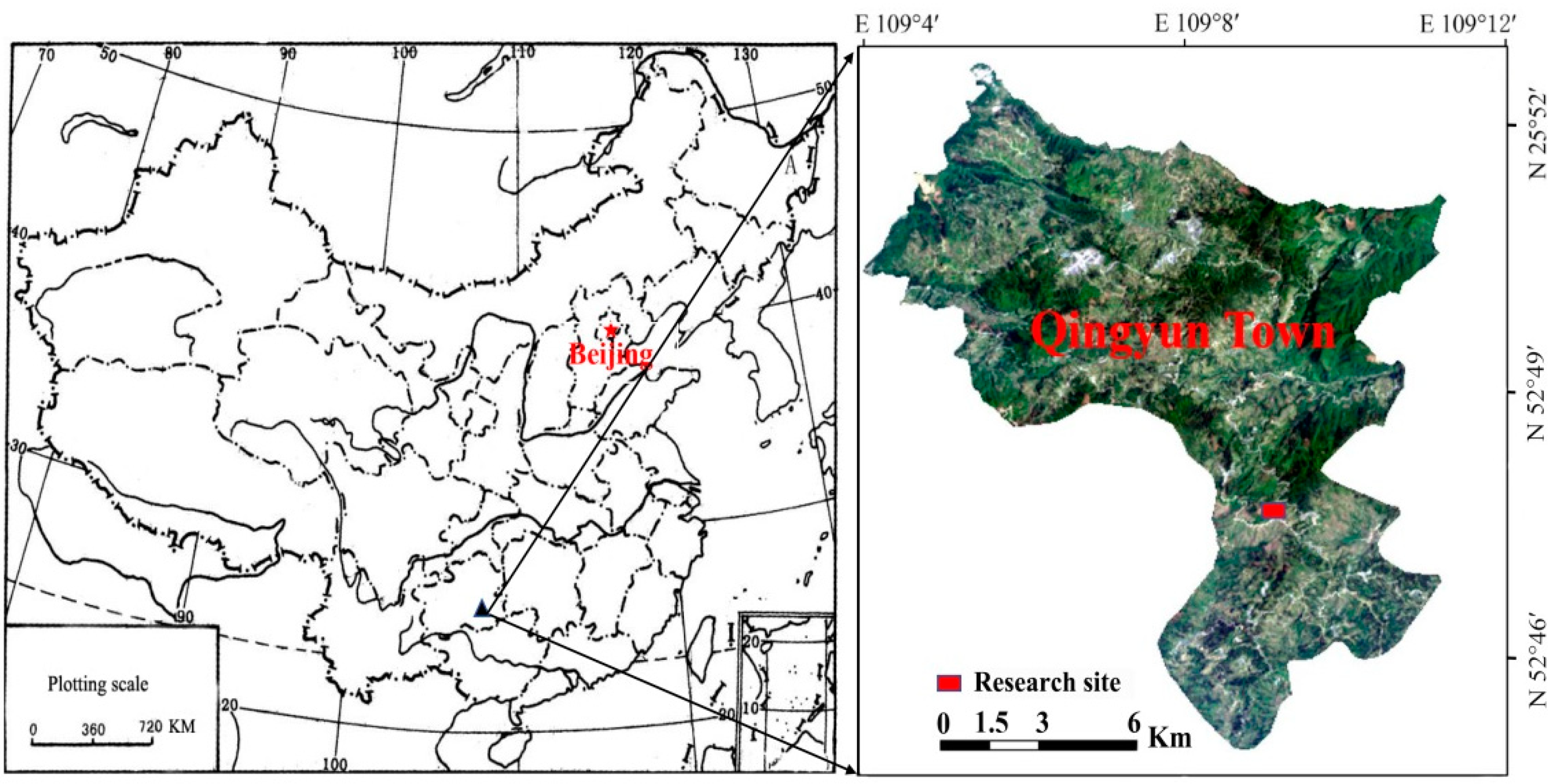
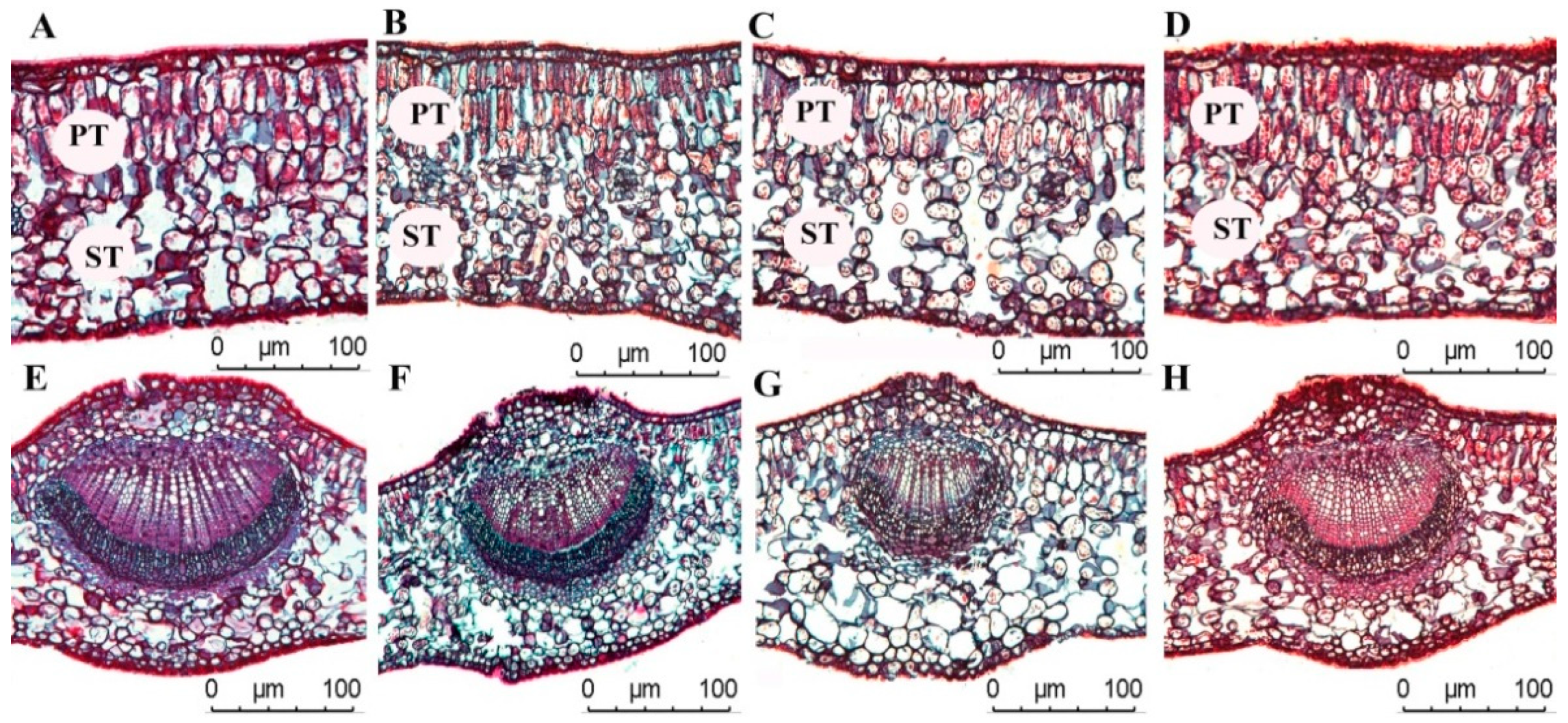
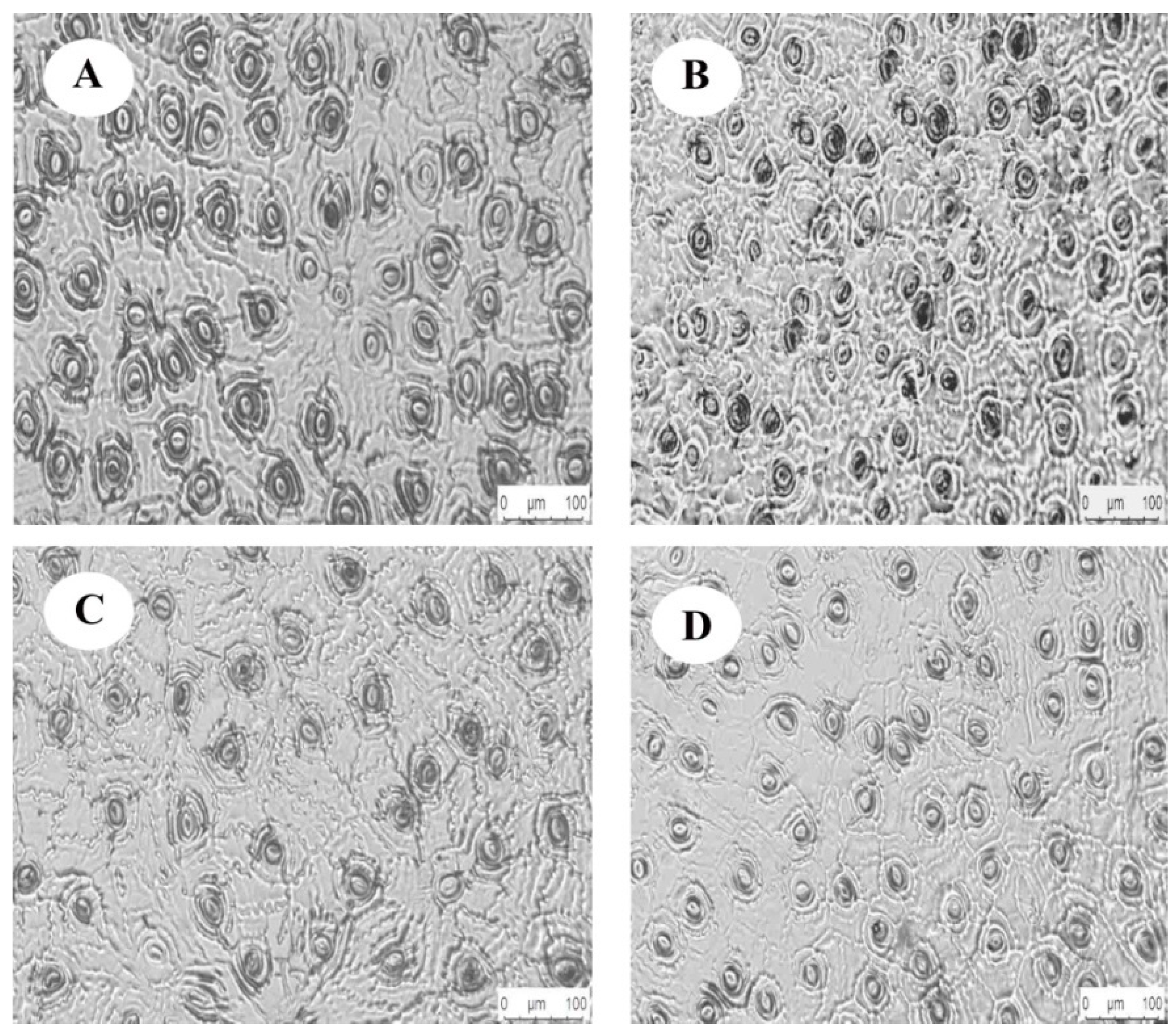

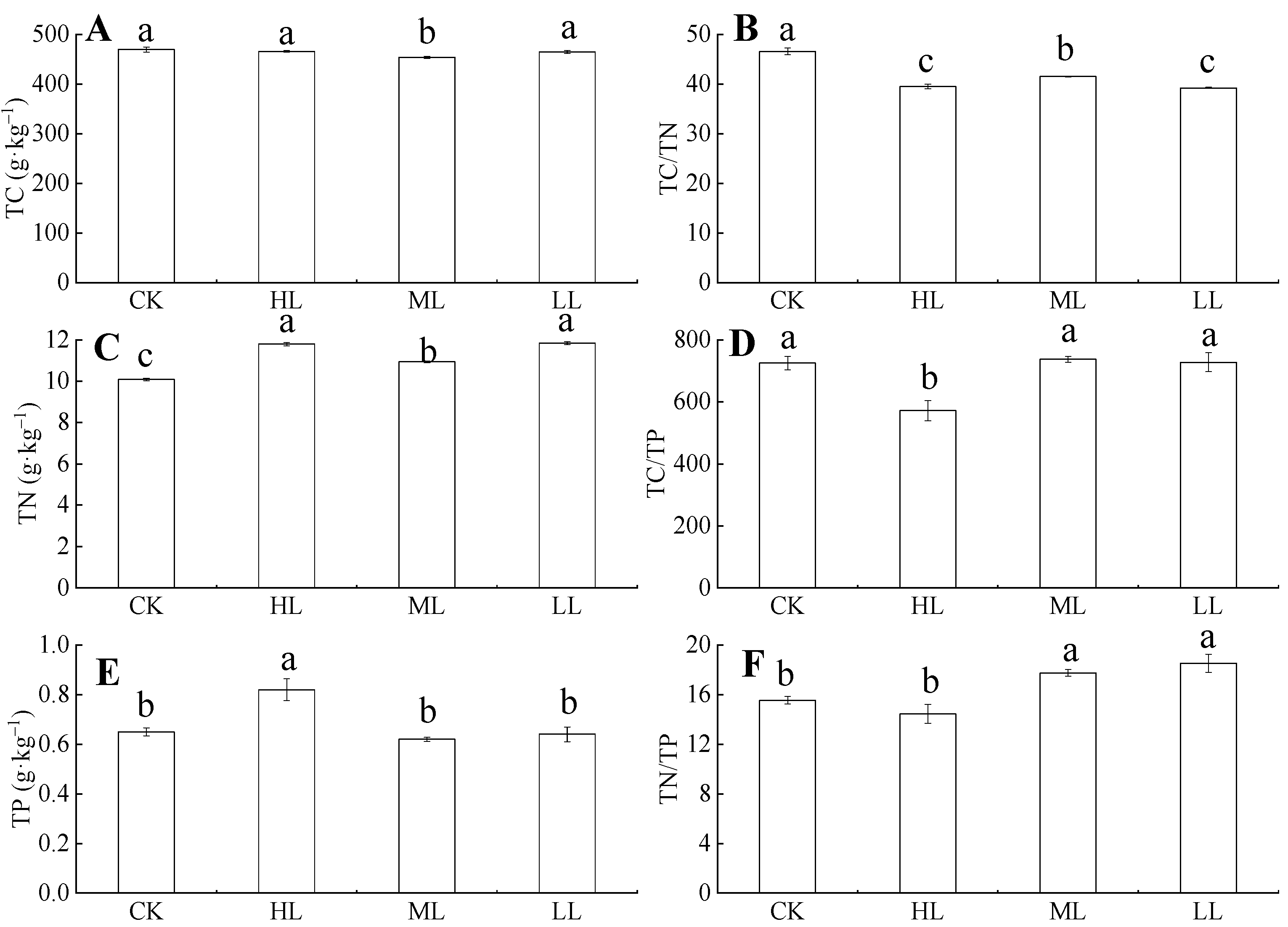


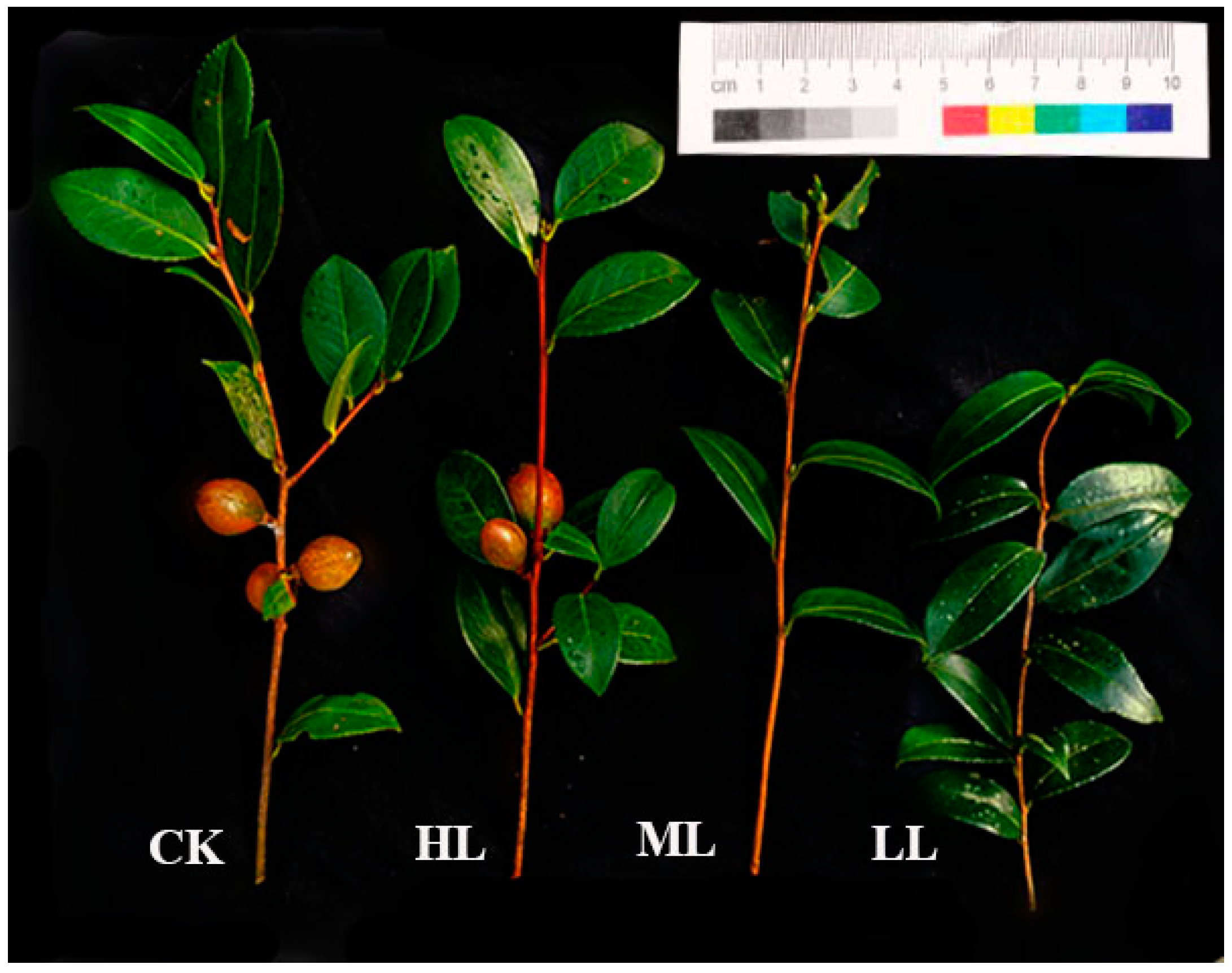
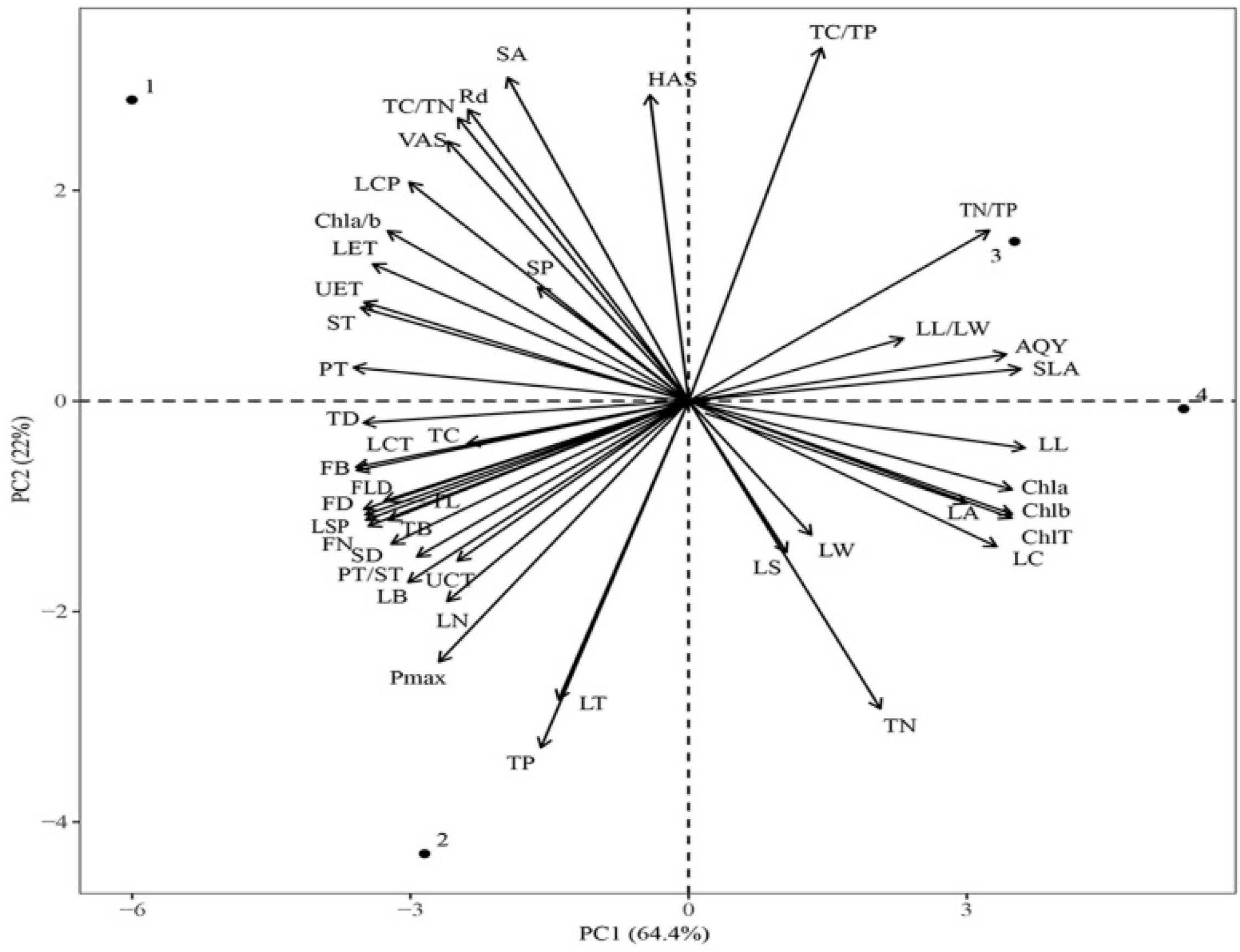
| Index | Light Regimes | Plasticity Indices | |||
|---|---|---|---|---|---|
| CK | HL | ML | LL | ||
| LL (mm) | 58.92 ± 4.71 c | 63.51 ± 3.18 b | 68.40 ± 1.98 b | 71.40 ± 5.14 a | 0.17 |
| LW (mm) | 31.38 ±2.37 b | 35.22 ± 3.08 a | 36.90 ± 2.11 a | 32.51 ± 1.67 b | 0.15 |
| LL/LW | 1.88 ± 0.23 b | 1.80 ± 0.14 b | 1.85 ± 0.18 b | 2.20 ± 0.25 a | 0.18 |
| LA (mm2) | 1284.21 ± 39.96 c | 1515.62 ± 50.86 b | 1682.81 ± 68.89 a | 1552.16 ± 54.05 b | 0.24 |
| LC(mm) | 146.88 ± 10.22 c | 158.35 ± 11.97 b | 162.63 ± 5.21 a | 163.18 ±8.34 a | 0.10 |
| LT (mm) | 0.44 ± 0.02 b | 0.48 ± 0.05 a | 0.45 ± 0.02 b | 0.43 ± 0.04 b | 0.10 |
| SLA (mm2 g−1) | 5.31 ± 0.97 c | 5.57 ± 1.01 c | 6.62 ± 0.78 b | 7.30 ± 1.25 a | 0.27 |
| LB (g) | 0.25 ± 0.03 a | 0.26 ± 0.01 a | 0.24 ± 0.03 a | 0.23 ± 0.02 a | 0.12 |
| LS | 2.44 ± 0.22 a | 2.78 ± 0.35 a | 2.89 ± 0.31 a | 2.51 ± 0.12 a | 0.16 |
| Index | Light Regimes | Plasticity Indices | |||
|---|---|---|---|---|---|
| CK | HL | ML | LL | ||
| UCT (μm) | 4.84 ± 0.38 b | 5.41 ± 0.71 a | 4.41 ± 0.53 b | 3.52 ± 0.88 c | 0.35 |
| LCT (μm) | 3.24 ± 0.41 a | 3.21 ± 0.36 a | 2.81 ± 0.45 b | 2.67 ± 0.52 b | 0.18 |
| UET (μm) | 22.29 ± 1.53 a | 18.59 ± 0.62 b | 16.81 ± 0.47 c | 14.08 ± 1.81 d | 0.39 |
| LET (μm) | 15.72 ± 0.71 a | 14.02 ± 0.67 b | 13.56 ± 0.52 c | 12.65 ± 0.94 d | 0.20 |
| PT (μm) | 162.51 ± 5.54 a | 148.32 ± 9.07 b | 130.69 ± 3.15 c | 116.83 ± 5.24 d | 0.28 |
| ST (μm) | 215.11 ± 3.15 a | 195.69 ± 14.79 b | 182.67 ± 11.32 c | 178.67 ± 12.15 d | 0.17 |
| PT/ST | 0.75 ± 0.04 a | 0.76 ± 0.03 a | 0.65 ± 0.02 b | 0.72 ± 0.01 a | 0.14 |
| Index | Light Regimes | Plasticity Indices | |||
|---|---|---|---|---|---|
| CK | HL | ML | LL | ||
| HAS (μm) | 22.41 ± 1.52 a | 18.44 ± 1.05 b | 23.48 ± 1.23 a | 18.71 ± 1.02 b | 0.22 |
| VAS (μm) | 17.23 ± 1.89 a | 14.88 ± 1.11c | 15.67 ± 2.28 b | 14.31 ± 0.97 c | 0.17 |
| SD (mm2) | 188.20 ± 2.71 b | 193.41 ± 7.86 a | 124.60 ± 4.8 d | 145.40 ± 4.03 c | 0.36 |
| SA (μm2) | 203.61 ± 8.62 a | 141.62 ±20.21 c | 171.18 ± 7.57 b | 146.71 ± 7.92 c | 0.30 |
| SP (μm) | 55.41 ± 2.31 b | 53.65 ± 4.36 b | 57.15 ± 2.11 a | 48.13 ± 2.62 c | 0.16 |
| Parameters | Light Regimes | Plasticity Indices | |||
|---|---|---|---|---|---|
| CK | HL | ML | LL | ||
| AQY | 0.0558 ± 0.003 c | 0.0566 ± 0.007 c | 0.0662 ± 0.005 b | 0.0762 ± 0.002 a | 0.27 |
| LSP (μmol m−2·s−1) | 1753.41 ± 65.26 a | 1830.12 ± 43.18 a | 1041.52 ± 43.62 b | 932.38 ± 31.54 c | 0.49 |
| LCP (μmol m−2·s−1) | 34.76 ± 2.13 a | 18.47 ± 1.25 b | 19.12 ± 1.06 b | 14.07 ± 2.28 c | 0.60 |
| Pmax (μmol m−2·s−1) | 6.03 ± 1.02 a | 6.48 ± 1.34 a | 5.61 ± 1.18 b | 5.66 ± 1.23 b | 0.13 |
| Rd | 1.59 ± 0.23 a | 0.93 ± 0.11 c | 1.10 ± 0.14 b | 0.97 ± 0.25 c | 0.42 |
| Index | Light Regimes | Plasticity Indices | |||
|---|---|---|---|---|---|
| CK | HL | ML | LL | ||
| TD (μm) | 2.88 ± 0.48 a | 2.65 ± 0.48 a | 2.06 ± 0.31 b | 2.20 ± 0.21 b | 0.28 |
| TL (cm) | 19.4 ± 5.94 a | 19.98 ± 5.77 a | 17.48 ± 4.63 b | 15.32 ± 2.68 b | 0.23 |
| LN (number) | 9.6 ± 4.36 a | 10.6 ± 2.65 a | 5.8 ± 0.75 c | 8.20 ± 2.48 b | 0.45 |
| TB (μm) | 30.15 ± 2.97 a | 29.96 ± 1.47 a | 13.99 ± 0.40 b | 12.82 ± 2.06 b | 0.87 |
| FD (μm) | 19.45 ± 2.41 | 19.85 ± 3.34 | - | - | 0.02 |
| FLD (μm) | 24.22 ± 1.59 | 25.27 ± 2.97 | - | - | 0.04 |
| FN (number) | 2.25 ± 0.75 | 2.43 ± 0.80 | - | - | 0.08 |
| FB (g) | 3.53 ± 0.56 | 3.06 ± 0.37 | - | - | 0.13 |
Publisher’s Note: MDPI stays neutral with regard to jurisdictional claims in published maps and institutional affiliations. |
© 2022 by the authors. Licensee MDPI, Basel, Switzerland. This article is an open access article distributed under the terms and conditions of the Creative Commons Attribution (CC BY) license (https://creativecommons.org/licenses/by/4.0/).
Share and Cite
Zhang, Y.; Guo, Q.; Luo, S.; Pan, J.; Yao, S.; Gao, C.; Guo, Y.; Wang, G. Light Regimes Regulate Leaf and Twigs Traits of Camellia oleifera (Abel) in Pinus massoniana Plantation Understory. Forests 2022, 13, 918. https://doi.org/10.3390/f13060918
Zhang Y, Guo Q, Luo S, Pan J, Yao S, Gao C, Guo Y, Wang G. Light Regimes Regulate Leaf and Twigs Traits of Camellia oleifera (Abel) in Pinus massoniana Plantation Understory. Forests. 2022; 13(6):918. https://doi.org/10.3390/f13060918
Chicago/Turabian StyleZhang, Yaqin, Qiqiang Guo, Siqiong Luo, Jinwen Pan, Shan Yao, Chao Gao, Youyan Guo, and Gang Wang. 2022. "Light Regimes Regulate Leaf and Twigs Traits of Camellia oleifera (Abel) in Pinus massoniana Plantation Understory" Forests 13, no. 6: 918. https://doi.org/10.3390/f13060918






